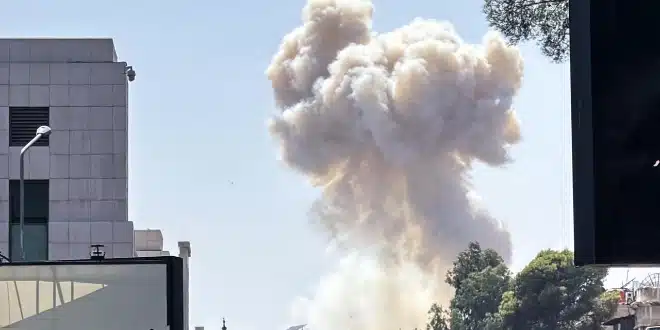Tensions surged across Syria on Wednesday as the Israeli military conducted rare airstrikes in central Damascus, directly targeting the Syrian Defense Ministry headquarters. The strikes came amid intensifying clashes in the southern city of Sweida between Syrian government forces and local Druze militias, marking one of the most volatile escalations since the collapse of Bashar al-Assad’s regime last December.
Airstrikes and Political Messaging
The Israeli assault came just hours after a drone reportedly struck the same government building. State-run Syrian media confirmed that at least one person had died, and 18 others were injured in the incidents. A separate Israeli strike also landed near the presidential palace, located in the hills surrounding the capital.
Following the attacks, Israeli Defense Minister Yoav Gallant declared that Israel had initiated “painful blows” and hinted at broader military operations if hostilities continued. According to an unnamed Israeli defense official, a military brigade is being withdrawn from Gaza and redirected to the Golan Heights, signaling potential further escalation.
Clashes in Sweida and Sectarian Tensions
The situation in Sweida, a city with a predominantly Druze population, has deteriorated rapidly. Fighting between government troops and local Druze fighters has continued for days, defying a ceasefire agreement brokered earlier in the week. Syria’s Defense Ministry accused Druze factions of violating the truce and defended its military response as necessary to protect civilians and restore order.
The broader conflict in Sweida began with tit-for-tat kidnappings and spiraled into armed confrontations. Social media videos have revealed disturbing images: Druze elders being publicly humiliated by regime-aligned forces, and retaliatory abuses by Druze fighters, including the capture and execution of soldiers. Reporters on the ground have documented burned homes and widespread looting in the region.
According to the Syrian Observatory for Human Rights, over 250 people have been killed since the start of the fighting, including dozens of civilians, children, and at least 138 government soldiers and security personnel. The Observatory also reported 21 field executions.
Human Impact and Stories from the Conflict
Civilians caught in the crossfire are facing harrowing conditions, compounded by disrupted communications. In Jaramana, near Damascus, 20-year-old Evelyn Azzam recounted losing contact with her husband, Robert Kiwan, who had been working in Sweida when violence broke out. She last spoke to him moments before he was shot during an encounter with security forces. “The ambulance took him to the hospital. Since then, we have no idea what has happened,” she said, holding back tears.
In the UAE, members of the Druze diaspora spoke anonymously about their fears for family members still in Sweida. One woman described her parents and sister hiding in a basement near a hospital, terrified as gunfire echoed outside. Another relative, she said, died in a house set ablaze—an incident that brought back memories of the 2018 Islamic State attack in Sweida, during which her uncle was killed defending the area while government forces failed to intervene.
Many Druze now view their fighters as the only line of defense against unchecked violence, especially in the face of what they see as state abandonment. “They’re just people protecting their province and their families,” one woman told the Associated Press.
Historical and Religious Background
The Druze community, a minority religious group with deep roots in Syria, traces its origins to a 10th-century branch of Ismaili Shiism. Today, an estimated one million Druze live worldwide, with the majority residing in Syria. Others are located in Lebanon, Israel, and the Israeli-occupied Golan Heights.
This complex religious and geographic positioning has often left the Druze caught between competing state powers, particularly in times of upheaval. In Syria, the community has been divided over how to engage with the country’s post-Assad leadership—some have advocated integration, while others push for regional autonomy.
Israel’s Expanding Role and Strategic Goals
Israel has expressed growing concern over developments in southern Syria. In addition to launching hundreds of airstrikes in recent years on Iranian and pro-Assad military targets, Israeli forces have also moved into U.N.-monitored buffer zones along the Syrian border near the Golan Heights, which Israel annexed in 1981 after seizing the territory in the 1967 Six-Day War.
Defense Minister Gallant said Israel would “continue to attack regime forces until they withdraw from the area,” warning of heightened retaliatory actions if the Syrian government ignores its warnings.
Israeli Prime Minister Benjamin Netanyahu also reiterated that Israel is committed to maintaining a demilitarized buffer zone in southwestern Syria to protect its northern frontier. He added that Israel has “an obligation to safeguard the Druze population” in the region—a rare public affirmation of solidarity with a group that has long served in the Israeli military and is considered a loyal minority.
Syrian Leadership Responds
Interim Syrian President Ahmad al-Sharaa condemned the widespread violence and acts of reprisal, issuing a statement Wednesday vowing accountability. “These criminal and illegal actions cannot be accepted under any circumstances,” the statement read, pledging that both individuals and factions operating outside state authority would face justice.
Meanwhile, Druze communities in the Israeli-controlled Golan Heights have staged protests at the border, denouncing the violence against their kin in Syria and calling for international intervention to protect civilians.
A Conflict Far from Over
The unfolding events in Syria signal a deepening crisis with regional implications. Israel’s increased military activity, the fragmentation of authority in southern Syria, and the vulnerability of minority groups like the Druze all point to a volatile landscape with no clear resolution in sight.
As new power dynamics settle into place following the downfall of Assad, the coming weeks may determine whether the country can stabilize—or plunge further into chaos.


